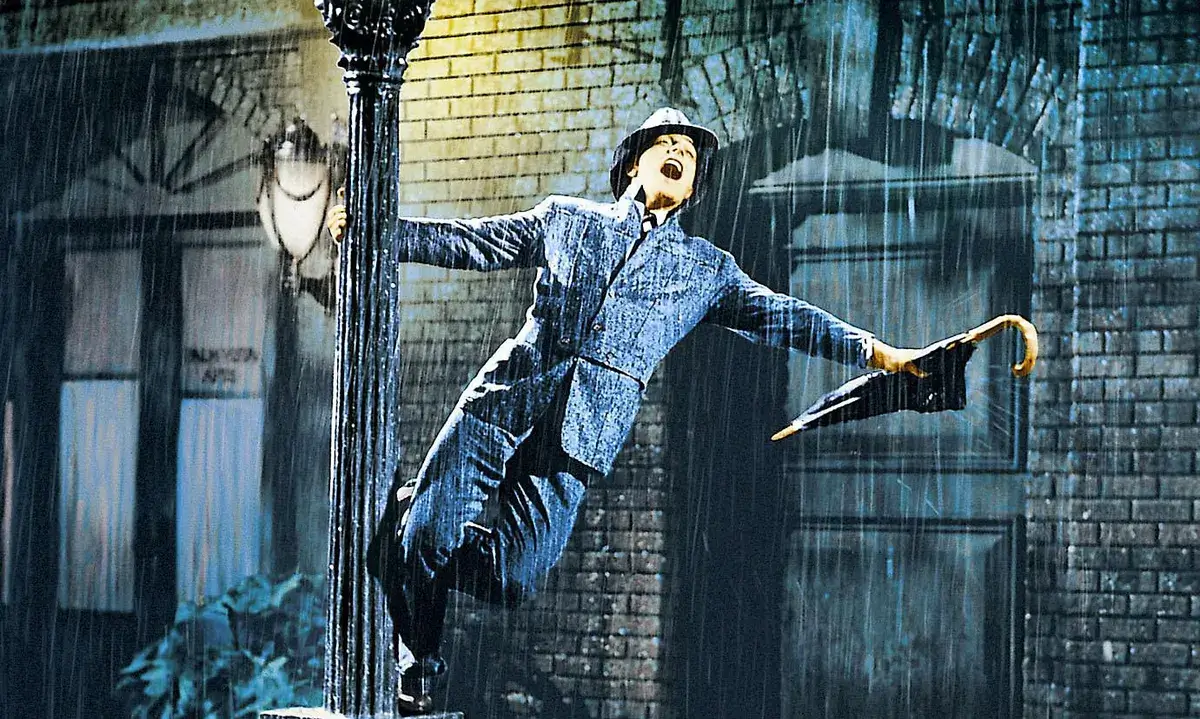There is no comfort entertainment quite like Gene Kelly and Stanley Donen’s Singin’ in the Rain. Each and every time I watch it (which I imagine has entered the double digits at this point), Donen and Kelly wrap me up again in their warm melodic blanket and tease a smile onto my face with their comedy and their unmatched visual design. As enthralling and comforting as it is to watch (and watch and watch) at home, seeing Singin’ in the Rain in a theater is a completely different experience. The movement, the mirth, and the music has never felt grander or more essential than on the big screen. Gene Kelly’s toothy smile fills the room, and his dancing shakes it. Singin’ in the Rain may be a glorified Greatest Hits of MGM, but it’s also a deeply reflective analysis on Hollywood and fame, and one of the greatest entertainments cinema has to offer.
The film opens with a premiere, the camera making its way through the crowd and their cheers to introduce our players: Don Lockwood (Gene Kelly), a former stuntman turned star, his best friend Cosmo (Donald O’Connor), a musician, and Lena Lamont (Jean Hagen), the second half of screen duo Lockwood and Lamont. Arriving at the premiere in a stunning white suit, Lockwood steps up to the mic and recounts his life story, recounting his motto: “Dignity, always dignity.” The irony of the saying is immediately apparent — right away, we’re shown the underbelly of show business, the struggles and indignities that lead to a life of success. This contextualizes the rest of what we’re shown in the film — we simply cannot forget how these people got here, and how differently they act once they’re on the top. The mythmaking of Hollywood is at once deconstructed and then carefully reconstructed over the course of the film, ironically crafting screen personas for Kelly, Hagen and O’Connor that are as hypnotically compelling as Lockwood and Lamont seem to be for audiences in the film.
The cultural critique of Singin’ in the Rain sits beneath it all, but never manages to dim the joy of the numbers and the people who perform them. The music of the film serves many different ends: statements of purpose (“Make ‘Em Laugh”), expressions of deep romantic feeling (“You Were Meant For Me”), and pure unadulterated nonsequiteur fun (“Moses”). The central number, though, is the title one, and it never fails to impress. For all the flashy, complex dancing of the numbers with Kelly and O’Connor, and the intricate visual design of pieces like The Broadway Melody, “Singin’ in the Rain” stands above the rest because of its simplicity. Whether you understand the verbal message of the song doesn’t matter — Kelly’s blinding white smile as he grips that lamp post under that downpour says it all. “Singin’ in the Rain” is perhaps the greatest example of why musicals are still so important to cinema. Inside the emotion of the words, and the expressions on the actors’ faces, there is always the compelling glory of their movement and their voices. Cinema was made to capture the magic of the musical, and the musical was made to fulfill its destiny with Singin’ in the Rain.
The restoration did the film justice, but it was not the grand, revolutionary kind of work I’ve seen at this festival (Daisies, The Trial). Singin’ in the Rain was great twenty years ago in Standard Definition. It was great ten years ago in HD, and it is great now in 4k. At this point I can confidently say no amount of polishing will reveal anything new about the film — Rain does that for itself on each new watch. The laughs continue to sound, the songs continue to rock the house, and the grand cinematic expressionism of Singin’ in the Rain continues to ring out on and on. For as long as I watch movies, I will watch Singin’ in the Rain, and life will always be better for it.
